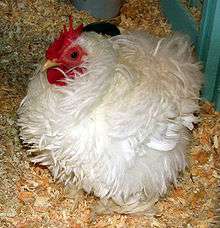Frizzle (chicken breed)

|
A frizzle-feathered chicken at the Minnesota State Fair in Falcon Heights, Minnesota, USA; possibly not of the frizzle breed | |
| Use | fancy, eggs |
|---|---|
| Traits | |
| Weight |
Male: Standard: 3.2–3.6 kg Bantam: 680–790 g[1] |
|
Female: Standard: 2.25–2.7 kg Bantam: 570–680 g[1] | |
| Egg color | white or tinted[1] |
| Comb type | single |
| Classification | |
| EE | Standard and bantam recognised[2] |
| PCGB | soft feather: heavy[3] |
| Notes | |
| clean legged | |
|
Chicken Gallus gallus domesticus | |
The Frizzle is a breed of chicken with characteristic curled or frizzled plumage. While the frizzle gene can be seen in many breeds, such as the Pekin and Polish, the Frizzle is recognised as a distinct breed in a number of European countries[2][4] and Australia.[5] In the United States frizzled chickens are not considered a breed, and at shows are judged by the standards of the breed they belong to.[6]
History
The origin of the Frizzle is unknown. The frizzle gene is thought to have originated in Asia;[7] frizzled chickens have been reported from the Far East since the eighteenth century.[4] The Frizzle breed is the result of breeder selection for exhibition.[4][8] It is recognised in nine European countries: Belgium, Czech Republic, France, Germany, Ireland, Italy, Poland, Slovakia and the United Kingdom.[2][1]
Characteristics
The gene for the curling of the feathers is incompletely dominant over normal plumage; not all members of the breed display the desired frizzling. Frizzled birds are heterozygous for the gene; when two are bred, the offspring inherit the gene in the usual Mendelian 1:2:1 ratio: 50% are heterozygous and frizzled like the parents, 25% have normal feathering, and 25% are "over-frizzled", with brittle feathers resembling pipe-cleaners. The Frizzle has a single comb and is featherfooted.
The Frizzle is a good layer of white or tinted eggs, and frequently gets broody.[7] It is a good forager and is hardy,[4] although the curled feathers do not protect it well from rain.
Four colours are recognised in the Entente Européenne standard: black, blue, cuckoo and white.,[2] the Poultry Club of Great Britain recognises thirteen colours for both standard and bantam sizes;[9] not all of them are currently bred,[4] and the Australian Poultry Standards recognise black, blue, buff, white, columbian, red and "any recognised colour".[5]
See also
References
- 1 2 3 4 Victoria Roberts (2008). British poultry standards: complete specifications and judging points of all standardized breeds and varieties of poultry as compiled by the specialist breed clubs and recognised by the Poultry Club of Great Britain. Oxford: Blackwell. ISBN 9781405156424. p. 121.
- 1 2 3 4 Liste des races et variétés homologuée dans les pays EE (28.04.2013). Entente Européenne d’Aviculture et de Cuniculture. Archived 16 June 2013.
- ↑ Breed Classification. Poultry Club of Great Britain. Accessed August 2014.
- 1 2 3 4 5 Welcome. The Frizzle Society of Great Britain. Archived 30 September 2012.
- 1 2 Australian Poultry Standards (2nd ed.). Victorian Poultry Fanciers Association (trading as Poultry Stud Breeders and Exhibitors Victoria). 2011. p. 79. ISBN 978-1-921488-23-8.
- ↑ Carol Ekarius (2007). Storeys Illustrated Guide to Poultry Breeds. North Adams, MA: Storey Publishing. ISBN 9781580176682. p. 24.
- 1 2 Frances Bassom (2009). Chicken breeds & care: a color directory of the most popular breeds and their care (1. ed.). Buffalo, N.Y.: Firefly Books. p. 137. ISBN 978-1-55407-473-0.
- ↑ Chris Graham (2006). Choosing and Keeping Chickens. London: Hamlyn. ISBN 9780600614388. p. 102–103.
- ↑ Frizzle Breed Standards. The Frizzle Society of Great Britain. Archived 16 October 2012.